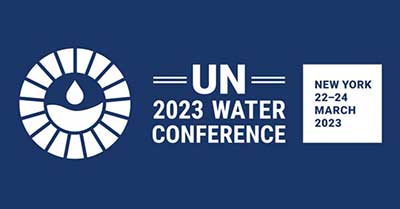Date: 06/04/2023
Relevance: GS-3: Conservation, Environmental Pollution, and Degradation, Environmental Impact Assessment.
Key Phrases: United Nations 2023 Water Conference, International Decade for Action, SDG 6, Groundwater over-abstraction, Sustained Access to Water and Sanitation, Water for Women Fund, Hydrological Status and Outlook System, W12+ Blueprint.
Why in News?
- The United Nations 2023 Water Conference held in New York on March 22-24 was the first such meeting on water after 46 years.
- The conference coincided with the mid-term comprehensive review of the International Decade for Action.
- In a report entitled ‘Water for Sustainable Development 2018–2028’, the U.N. recognized the urgent need for action given that we are not on track to meet the 2030 Sustainable Development Goal (SDG) no. 6 for water: “Ensure availability and sustainable management of water and sanitation for all”.
Localised nature of water problem:
- The water sector is prone to fragmentation due to the localized nature of water problems.
- Each region may have specific water-related issues such as water pollution, frequent flooding, or lack of drinking water supply.
- These challenges need local solutions and the mobilization of global efforts to solve them.
Purpose of the water conference:
- International water conferences aim to bring together various stakeholders such as governments, companies, NGOs, and funders to address common water-related challenges.
- These conferences facilitate learning from the experiences of others, technology transfer, and investment.
Impact of the 1977 U.N. Water Conference
- The 1977 U.N. Water Conference was a significant milestone in achieving a global 'Action Plan' that recognized the right of all people to have access to safe drinking water.
- The declaration resulted in decades of global funding and efforts to provide drinking water and sanitation for all, which substantially reduced the population without access to safe drinking water in developing countries.
Was the new conference similarly effective?
- Challenges of Extending Services to Underserved Populations:
- While extending access to safe drinking water and sanitation to underserved populations is relatively uncontroversial, finding the money to pay for it remains a challenge.
- India has implemented government programs such as Swachh Bharat Mission and Jal Jeevan Mission to address this issue.
- Sustained Access to Water and Sanitation:
- Improving access to water and sanitation is no longer enough to ensure sustained access.
- Groundwater over-abstraction, often driven by agricultural pumping, has led to many failed drinking water projects, leaving communities without access.
- Addressing the Over-abstraction Problem:
- To solve the over-abstraction problem in heavily irrigated areas, such as Punjab or the Cauvery Delta, farmers must pump less.
- This requires changes in agricultural policies, which in turn requires coordination among various agencies and ministries.
- The Broader Water Problem:
- Access to water and sanitation represents only two of the eight water-related SDGs.
- The remaining SDG 6 targets address the need to sustain agriculture, industry, and natural ecosystems, which require tough political choices and strengthening democratic processes.
What were the conference’s outcomes?
- Technology:
- There were specific innovations in wastewater treatment or solar treatment of water in remote areas, and a number of proposals for incubation platforms, including the IBM Sustainability Accelerator, focused on water management.
- Data and models:
- Before every large investment, its potential impact must be anticipated. Simulations are often important to do this, and they need large amounts of input data.
- Cost-effective approaches to data generation included sensors and satellite data.
- Other efforts, like the World Meteorological Organisation’s Hydrological Status and Outlook System, offered data analysis tools.
- Knowledge sharing:
- Solutions to most of these problems already exist, but each region and country often reinvent the wheel. The cross-learning needs to be accelerated.
- One useful tool here was the W12+ Blueprint, a UNESCO platform that hosts city profiles and case studies of programs, technologies, and policies that address common water security challenges.
- Capacity building :
- Many people lack access to basic services because they are unable to advocate for themselves and because infrastructure projects are designed for and by powerful actors in society.
- Efforts like the Making Rights Real initiative offered to help marginalized communities and women understand how to exercise their rights.
- Similarly, the ‘Water for Women Fund’ offered support mechanisms for more effective and sustainable water, sanitation, and hygiene outcomes for women.
- Civil society:
- There were several platforms for collective action by civil society groups lobbying for changes in regulations, e.g., creating transnational networks to advocate for national and international bodies to criminalize the use of certain pesticides harmful to aquatic life.
- Environmental, social, and corporate governance:
- The conference concluded that a big barrier to farmers and industries using water more efficiently is that they have no incentive.
- Specifically, farmers aren’t becoming more efficient or going pesticide-free unless consumers are willing to pay a premium for more sustainably produced goods.
Conclusion
- The U.N. Water Conference 2023 was a comprehensive review of the water sector's challenges, which require tough political choices, empowering agencies, and strengthening democratic processes.
- The conference outcomes reflected the complexity of the water problem and the diverse voluntary commitments that need to be acted upon to achieve the sustainable development goals for water by 2030.
Source: The Hindu
Mains Question:
Q. Analyse the outcomes and challenges of the United Nations Water Conference 2023 in addressing the global water crisis and achieving Sustainable Development Goal 6. Discuss the key commitments made at the conference and their potential in tackling the complex and interconnected water-related issues.






















